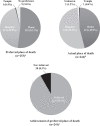Symptom Prevalence and Place of Death Preference in Advanced Cancer Patients: Factors Associated With the Achievement of Home Death
- PMID: 34657488
- PMCID: PMC9210115
- DOI: 10.1177/10499091211048767
Symptom Prevalence and Place of Death Preference in Advanced Cancer Patients: Factors Associated With the Achievement of Home Death
Abstract
Objectives: Achievement of patients' preferred place of death is recognized as a component of a good death. This study aimed to investigate the symptom burden in advanced cancer patients, achievement of their place of death preferences and factors associated with home death.
Methods: In this retrospective review of 287 patient deaths, we examined patients' symptom prevalence, preferred and actual place of death and achievement of their place of death preferences using descriptive statistics. Associations between patient factors, home death preference and actual home death were further analyzed using multivariate logistic regression.
Results: The most prevalent symptoms were weakness, pain and poor appetite, with a mean of 5.77(SD: 2.37) symptoms per patient. The median interval from palliative care referral to death was 21 (IQR: 74) days. Of the 253 patients with documented place of death preference, 132 (52.1%) preferred home death, 111(43.9%) preferred hospital death, 1 (0.4%) preferred to die at a temple and 9(3.6%) expressed no preference. Overall, 221 of 241(91.7%) patients with known actual place of death achieved their preference. Older patients were more likely to prefer home death (OR 1.021; 95% CI 1.004-1.039, p = 0.018) and die at home (OR 1.023; 95% CI 1.005-1.041, p = 0.014). Gender, marital status, cancer diagnosis and symptoms were not associated with preference for or actual home death.
Conclusion: Despite a high symptom burden, most patients preferred and achieved a home death. Late palliative care referral and difficult symptom management contributed to failure to fulfill home death preference. Preference for home death should be considered when managing terminally ill geriatric patients.
Keywords: cancer; geriatrics; home death; palliative care; place of death preference; symptom.
Conflict of interest statement
Figures




Similar articles
-
Social and clinical determinants of preferences and their achievement at the end of life: prospective cohort study of older adults receiving palliative care in three countries.BMC Geriatr. 2017 Nov 23;17(1):271. doi: 10.1186/s12877-017-0648-4. BMC Geriatr. 2017. PMID: 29169346 Free PMC article.
-
Predictors of the final place of care of patients with advanced cancer receiving integrated home-based palliative care: a retrospective cohort study.BMC Palliat Care. 2021 Oct 18;20(1):164. doi: 10.1186/s12904-021-00865-5. BMC Palliat Care. 2021. PMID: 34663303 Free PMC article.
-
Congruence between Preferred and Actual Place of Death for Those in Receipt of Home-Based Palliative Care.J Palliat Med. 2020 Nov;23(11):1460-1467. doi: 10.1089/jpm.2019.0582. Epub 2020 Apr 15. J Palliat Med. 2020. PMID: 32286904
-
Patient and Family Preferences About Place of End-of-Life Care and Death: An Umbrella Review.J Pain Symptom Manage. 2024 May;67(5):e439-e452. doi: 10.1016/j.jpainsymman.2024.01.014. Epub 2024 Jan 17. J Pain Symptom Manage. 2024. PMID: 38237790
-
Factors associated with congruence between preferred and actual place of death.J Pain Symptom Manage. 2010 Mar;39(3):591-604. doi: 10.1016/j.jpainsymman.2009.07.007. Epub 2010 Jan 29. J Pain Symptom Manage. 2010. PMID: 20116205 Free PMC article. Review.
Cited by
-
Factors affecting the place of death in patients with liver cancer in China, 2013-2020: A population-based study.Cancer Pathog Ther. 2024 Apr 12;3(2):163-172. doi: 10.1016/j.cpt.2024.04.001. eCollection 2025 Mar. Cancer Pathog Ther. 2024. PMID: 40182117 Free PMC article.
-
Factors Influencing the Quality of Life (QOL) of Advanced Cancer Patients in Home-based Palliative Care (HBPC): A Systematic Review.Asian Pac J Cancer Prev. 2024 Nov 1;25(11):3789-3797. doi: 10.31557/APJCP.2024.25.11.3789. Asian Pac J Cancer Prev. 2024. PMID: 39611901 Free PMC article.
-
Trends and determinants of place of death among Chinese lymphoma patients: a population-based study from 2013-2021.Am J Cancer Res. 2023 Sep 15;13(9):4246-4258. eCollection 2023. Am J Cancer Res. 2023. PMID: 37818048 Free PMC article.
-
Influencing factors of home hospice care needs of family caregivers of the older adult with chronic diseases at the end of life in China: a cross-sectional study.Front Public Health. 2024 May 2;12:1348285. doi: 10.3389/fpubh.2024.1348285. eCollection 2024. Front Public Health. 2024. PMID: 38756894 Free PMC article.
-
Preferred place of death and end-of-life care for adult cancer patients in Iran: A cross-sectional study.Front Oncol. 2022 Aug 3;12:911397. doi: 10.3389/fonc.2022.911397. eCollection 2022. Front Oncol. 2022. PMID: 35992820 Free PMC article.
References
-
- Department of Health. End of Life Care Strategy—Promoting High Quality Care of All Adults at the End of Life. Department of Health; 2008.
-
- Brogaard T, Neergaard MA, Sokolowski I, Olesen F, Jensen AB. Congruence between preferred and actual place of care and death among Danish cancer patients. Palliat Med. 2013;27(2):155–164. - PubMed
-
- Hunt KJ, Shlomo N, Addington-Hall J. End-of-life care and achieving preferences for place of death in England: results of a population-based survey using the VOICES-SF questionnaire. Palliat Med. 2014;28(5):412–421. - PubMed
MeSH terms
LinkOut - more resources
Full Text Sources
Medical

